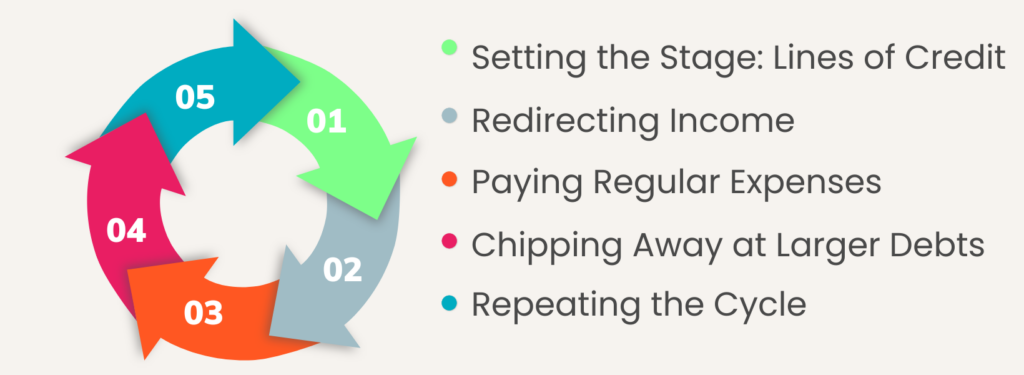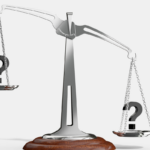
Velocity banking is not merely a financial strategy—it’s an innovative approach to understanding and addressing debt. By harnessing this methodology, you’re positioned to optimize each dollar to its fullest potential, channeling resources effectively to accelerate your journey toward financial liberation. If you’re pondering when and how this approach could fit into your personal financial landscape, this blog goes over the best scenarios to leverage Velocity Banking.
Understanding the Core Principles of Velocity Banking
The Power of a Line of Credit
particularly the Home Equity Line of Credit (HELOC). Distinct from conventional loans, a HELOC provides borrowers with a flexible financial reservoir. It enables users to not only borrow but also repay and subsequently re-access funds, aligning perfectly with the fluidity and demands of real-life situations.
Key Points:
- Interest Calculation: One standout feature of many lines of credit, including HELOCs, is the way interest is computed. Typically, interest is calculated on a daily basis. This means that as you reduce your balance, even if only temporarily, you’ll see a consequent decrease in interest expenses. The sooner you lower that balance, the less you end up paying in interest.
- Accessibility: Once approved, you are at liberty to draw from a HELOC as and when needs arise, subject to the stipulated limit. This kind of financial flexibility is invaluable, especially in scenarios where cash flow requirements can fluctuate, from home renovations to unexpected emergencies.
Leveraging Your Income
In velocity banking, your monthly income acts as a tool. By channeling your entire income into your line of credit, you immediately reduce the balance and thus the interest accruing on it.
Key Points:
- Interest Savings: By consistently reducing the principal balance, you save substantially on interest over time.
- Rapid Debt Reduction: As you reduce the principal faster, the lifetime of your debt shrinks considerably.
The Steps to Implement Velocity Banking
1. Open a Line of Credit
While there are multiple credit options, a Home Equity Line of Credit (HELOC) is often preferred due to its lower interest rates and tax-deductible interest. Ensure you get a revolving line of credit, which will allow you to re-borrow what you’ve repaid.
2. Deposit Your Income
Redirect your monthly income into the line of credit. This immediate influx will drastically cut down the balance and thus the interest accruing.
3. Cover Expenses from the Credit Line
Use this line of credit to handle monthly expenses. Since you’re using money from the credit line, the balance will rise, but at a slower pace due to your income being deposited into it.
4. Chip Away at Larger Debts
As you stabilize your financial footing with the previous steps, now is the time to target those more substantial debts that often hang heavy on the balance sheet. Allocate a portion of your available credit towards these debts, prioritizing those with the highest interest rates.
By methodically reducing these, you’re not only improving your debt-to-income ratio but also freeing up more funds in the long run, which can then be re-invested back into the line of credit. This step is crucial in propelling your velocity banking strategy forward, ensuring you’re continually breaking down larger financial barriers.
5. Repeat the Process
As you continue to channel your income into the line of credit and cover expenses, you’ll notice a cyclical trend – the balance will keep decreasing faster than with a traditional repayment method.

Personal Scenarios Where Velocity Banking Makes Sense
1. Unlocking the Power of Home Equity
Debt can often feel like a heavy, never-ending rainstorm, with every droplet representing the accumulating interest. Yet, there’s a shelter within this downpour: your home. Over the years, as you’ve made payments towards your home, you’ve unknowingly built a resource known as equity. Think of it like a treasure trove, slowly filling up over time. This is where the magic of a Home Equity Line of Credit (HELOC) comes in.
A HELOC isn’t just another loan; it’s a special financial tool, distinct because of its favorable interest rates. Most of us grapple with loans that have high interest rates, which means a large chunk of our repayments goes into the interest and not the principal amount. A HELOC, with its lower rates, flips this. This shift allows more of your money to directly tackle the debt, facilitating a quicker clearance. Over a span of months and years, this could translate into significant savings and a faster path to being debt-free. Essentially, it’s like turning your home into an ally in your battle against debt.
2. Amplifying Investment Opportunities with Lines of Credit
The world of investment is vast and varied, offering numerous avenues that promise lucrative returns. Stocks, mutual funds, bonds – the opportunities are plentiful. However, a common hurdle for many is the lack of immediate capital. The velocity banking strategy offers a workaround to this impediment. Picture this: a reservoir of funds, available to you, ready to be deployed as and when an investment opportunity strikes. No more missed opportunities due to a lack of immediate cash.
This method offers an agile way to engage with investments. Rather than waiting on the sidelines, accumulating the required capital, you can dive right in. Moreover, the investment world often values consistency. It’s not always about hitting the jackpot overnight but steadily building your portfolio over time. With velocity banking, this consistency becomes more attainable, potentially putting you on a trajectory for long-term financial growth.
3. Preparing for Life’s Uncertainties
Life is an unpredictable journey, filled with ups and downs. These ‘downs’ often come with a financial implication, be it an unexpected medical bill, a sudden car repair, or any other unforeseen expenditure. Such situations underscore the importance of having a financial safety net. A HELOC, in the context of velocity banking, can be this very net, providing both financial security and mental peace.
Consider the assurance that comes from knowing that you have funds available in case of emergencies. No scrambling for loans, no borrowing from friends or family – just a ready reservoir of funds, waiting to be tapped into. Over time, this peace of mind can be invaluable, allowing you to navigate life’s uncertainties with a bit more confidence.
4. Expanding Real Estate Endeavors with Velocity Banking
The allure of real estate is hard to resist. Whether it’s the idea of owning a vacation home or diving into the world of property flipping, real estate promises both tangible and intangible returns. However, one of the primary challenges in this field is the significant capital requirement. Here, velocity banking emerges as a game-changer.
With a credit line at your disposal, real estate projects become more feasible. Whether it’s a down payment for a new property, funds for renovation, or capital for a flip project, the required money is just a transaction away. This ease of access can significantly change the dynamics of real estate investment, allowing for more projects, better properties, and potentially, higher returns.
5. Steering Business Expansion and Seizing Opportunities
In the dynamic world of business, time often equates to money. Opportunities arise and, if not seized promptly, can dissipate just as quickly. Whether it’s expanding operations, launching a new product line, or capitalizing on a market trend, businesses frequently require an infusion of funds. This is where velocity banking can play a pivotal role.
Imagine the flexibility that comes with a ready line of credit. Need to ramp up production because of a sudden surge in orders? No problem. Found a lucrative market segment that requires quick entry? You’re covered. This agility can be the difference between capitalizing on an opportunity and watching it pass by.
6. Sculpting a Tailored Retirement Strategy
Retirement is often visualized as a serene phase of life, marked by relaxation and leisure. However, realizing this dream necessitates careful planning and ample resources. Here, velocity banking can offer a unique advantage. By efficiently managing your current financial scenario, and potentially reducing years off your debt, you can realign your finances to better prepare for retirement. Whether it’s investing in retirement funds, clearing debts, or even planning early retirement, the financial flexibility offered by Velocity Banking can be transformative.
Concluding Thoughts: Personalizing Velocity Banking to Your Needs
Everyone dreams of retiring peacefully, maybe by the beach or in a quiet countryside home. But to do that, you need a plan and the funds to support it. Velocity banking can be a part of this plan. By managing your finances smartly now, using tools like a HELOC, you can potentially enjoy your retirement even earlier than you thought.

FAQs
- What is Velocity Banking?
- Velocity Banking is a financial strategy that leverages a Home Equity Line of Credit (HELOC) or other types of lines of credit. The primary aim is to accelerate debt repayment and reduce interest costs. By directing income towards the HELOC and subsequently using it to cover expenses and bills, individuals can decrease the average daily balance on which interest is calculated. This approach, when executed effectively, can lead to faster mortgage payoffs and significant interest savings.
- Is a good credit score essential for velocity banking?
- A decent credit score can be beneficial as it can provide access to better interest rates and larger credit lines, both crucial for optimizing the strategy.
- How can I determine if velocity banking suits me?
- Start by evaluating your debts, understanding your financial goals, and considering the flexibility and risks associated with your available lines of credit.
- Are there any hidden costs in velocity banking?
- While not hidden, there are costs like potential HELOC fees or interest rate fluctuations to consider. It’s vital to be well-informed and possibly consult with a financial expert.
- What is the difference between Velocity and Infinite Banking?
- Velocity Banking is a strategy that utilizes a Home Equity Line of Credit (HELOC) or other lines of credit to rapidly pay off debts by reducing average daily balances and subsequently, interest costs. On the other hand, Infinite Banking, also known as the “Nelson Nash method” or “Becoming Your Own Banker”, focuses on leveraging a dividend-paying whole life insurance policy. With this method, individuals build cash value inside the policy and can borrow against it, effectively channeling the interest back into their own “bank” rather than paying it to external lenders. While both methods aim to optimize personal finance, they operate on different principles and mechanisms.
- What are the problems with Velocity Banking?
- While Velocity Banking can be a potent tool for some individuals, it’s not without potential challenges. The primary issues include:
- Risk Exposure: Utilizing large portions of a HELOC or line of credit exposes individuals to the risk of fluctuating interest rates. If rates increase, so do the costs.
- Financial Discipline: The method requires strict financial discipline. Without careful management and consistent payments, one could end up in deeper debt.
- Dependence on Stable Income: If there’s a disruption in one’s source of income, managing payments and maintaining the strategy’s effectiveness can become challenging.
- Complexity: It’s not always straightforward. Understanding and managing balances, interest rates, and payment schedules can be complex, potentially leading to costly errors.
- Potential Fees: Some lines of credit may come with fees, such as transaction or annual charges, which can offset the benefits if not accounted for.
- While Velocity Banking can be a potent tool for some individuals, it’s not without potential challenges. The primary issues include:
Additional Resources
- Wealth Solutions Hub:
- Bankrate – A comprehensive site offering comparisons on mortgages, bank accounts, credit cards, insurance, and beyond.
- Credit Karma – Beyond its renowned free credit scores, it provides rate comparisons for diverse financial products





